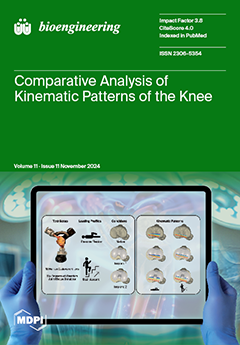Open AccessEditor’s ChoiceArticle
Around-Body Versus On-Body Motion Sensing: A Comparison of Efficacy Across a Range of Body Movements and Scales
by
Katelyn Rohrer, Luis De Anda, Camila Grubb, Zachary Hansen, Jordan Rodriguez, Greyson St Pierre, Sara Sheikhlary, Suleyman Omer, Binh Tran, Mehrail Lawendy, Farah Alqaraghuli, Chris Hedgecoke, Youssif Abdelkeder, Rebecca C. Slepian, Ethan Ross, Ryan Chung and Marvin J. Slepian
Cited by 1 | Viewed by 1427
Abstract
Motion is vital for life. Currently, the clinical assessment of motion abnormalities is largely qualitative. We previously developed methods to quantitatively assess motion using visual detection systems (around-body) and stretchable electronic sensors (on-body). Here we compare the efficacy of these methods across predefined
[...] Read more.
Motion is vital for life. Currently, the clinical assessment of motion abnormalities is largely qualitative. We previously developed methods to quantitatively assess motion using visual detection systems (around-body) and stretchable electronic sensors (on-body). Here we compare the efficacy of these methods across predefined motions, hypothesizing that the around-body system detects motion with similar accuracy as on-body sensors. Six human volunteers performed six defined motions covering three excursion lengths, small, medium, and large, which were analyzed via both around-body visual marker detection (MoCa version 1.0) and on-body stretchable electronic sensors (BioStamp version 1.0). Data from each system was compared as to the extent of trackability and comparative efficacy between systems. Both systems successfully detected motions, allowing quantitative analysis. Angular displacement between systems had the highest agreement efficiency for the bicep curl and body lean motion, with 73.24% and 65.35%, respectively. The finger pinch motion had an agreement efficiency of 36.71% and chest abduction/adduction had 45.55%. Shoulder abduction/adduction and shoulder flexion/extension motions had the lowest agreement efficiencies with 24.49% and 26.28%, respectively. MoCa was comparable to BioStamp in terms of angular displacement, though velocity and linear speed output could benefit from additional processing. Our findings demonstrate comparable efficacy for non-contact motion detection to that of on-body sensor detection, and offers insight as to the best system selection for specific clinical uses based on the use-case of the desired motion being analyzed.
Full article
►▼
Show Figures






